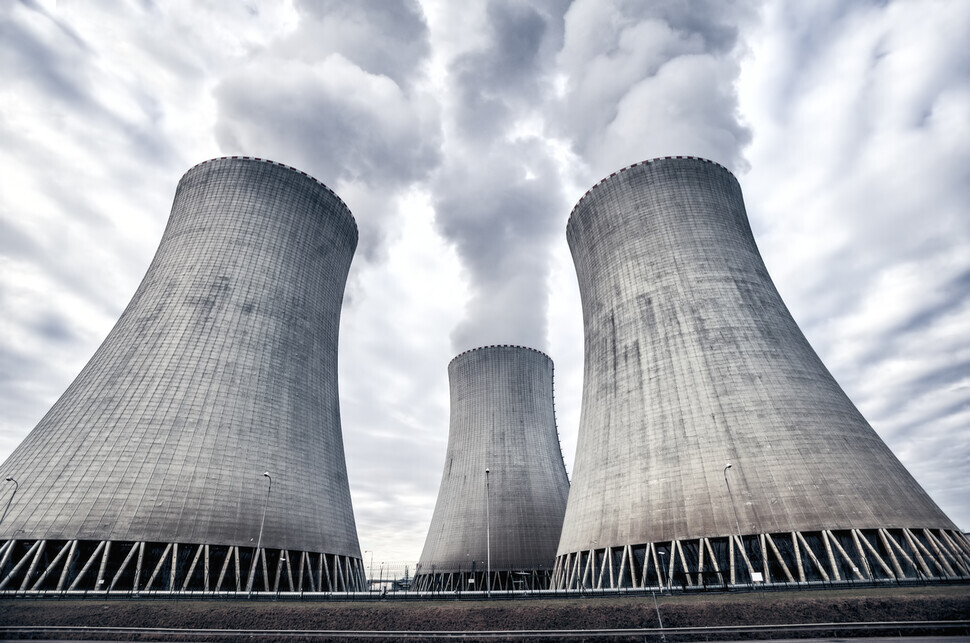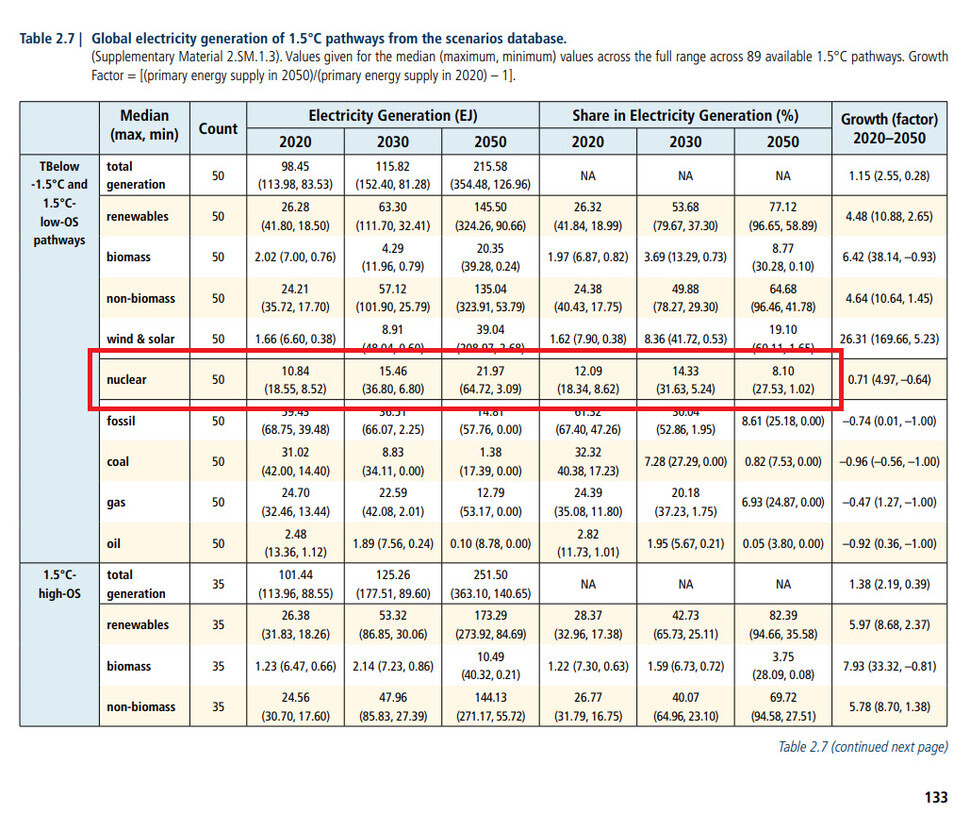hankyoreh
Links to other country sites 다른 나라 사이트 링크
Nuclear power advocates quote erroneous summary of UN report on climate change

The “Special Report on Global Warming of 1.5°C” approved by the Intergovernmental Panel on Climate Change (IPCC) in 2018 was an important document that officially presented “carbon neutrality by 2050” (meaning zero net carbon dioxide emissions) to the international community as a way of preventing the global average temperature from rising to 1.5°C above its pre-industrialization level. For those pursuing a shift away from nuclear power, the report has been both a stepping stone and a stumbling block for energy transitioning policies.
The report predicted that the average global temperature increase could be kept below 1.5°C if around 80% of electricity were supplied through new and renewable energy sources such as solar power through 2050. In this sense, it was a stepping stone. But in calling for a large-scale transition away from coal, it predicted a small increase in electricity generation for nuclear power. This was the stumbling block. Nuclear power advocates, including the nuclear engineering community and some media, have actively used this as a key basis in calling for an increase in the use of nuclear power — maintaining that a UN-affiliated group recommended an increase in nuclear power to stop global warming.
In a close reexamination of the special report’s content, the Hankyoreh confirmed with its coordinating lead authors that an error was present in the data that served as a basis for the advocates’ calls for expanding nuclear power. When asked by the Hankyoreh to verify the error, the authors said they had notified the secretariat and were pursuing revisions.

The confirmed error concerned the Summary for Policymakers (SPM) included in the special report, which was unanimously approved by the 195 member countries. Since the actual text is extremely long — stretching over five chapters and 562 pages — a summary is presented at the beginning on page 26 for policymakers in different countries. This summary is mainly what has been shared and quoted in the domestic news media.
An examination of the SPM on Nov. 9 showed that in its description of pathways for containing the rise in average global temperatures to within 1.5°C, it briefly states, “In electricity generation, shares of nuclear and fossil fuels with carbon dioxide capture and storage (CCS) are modeled to increase in most 1.5°C pathways with no or limited overshoot.” But this characterization is the exact opposite from the analytical data that are presented as a basis within the report’s main text.
With these pathways, global nuclear power generation was projected as roughly doubling from 10.84EJ (exajoules, or quintillions of joules) in 2020 to 21.97EJ by 2050. But in contrast with the summary’s reference to “increasing in most pathways,” the percentage of nuclear power out of all power sources over the same period actually declines from 12.09% to 8.1%. The reason has to do with predictions that with global electricity demand substantially increasing through 2050, renewable energy sources will cover this amount through a nearly six-fold increase from 26.28EJ to 145.50EJ. Renewable energy sources, including solar power, are projected to account for 77.12% for total electricity demand by 2050.
The Hankyoreh has received five responses since late September from three coordinating lead authors about this discrepancy between the summary and main text. Two of the authors agreed that the summary’s version differed from the facts. Joeri Rogelj of Imperial College called the discrepancy “an unfortunate inaccuracy,” adding, “Nuclear energy generation goes up in ‘most’ (that is more than half of the scenarios), but the share of total electricity is actually going down.”
Drew Shindell of Duke University said, “I have been in touch with my co-authors to confer on this and it seems Joeri has already written back to you. I concur with his reply to you.” Regarding the reason for the discrepancy, Rogelj said the inconsistency “is simply an unfortunate inaccuracy that would best be rectified.” He also said the lead authors had “informed the IPCC secretariat about this inconsistency, but haven’t had a reply yet. For comparison, in earlier instances where we highlighted errata the response also wasn’t very quick.”

The explanations from nuclear power scholars and others in claiming that the IPCC “recommended” an increase in nuclear power, or that the special report concluded an increase in nuclear power to be the only way to respond to the climate crisis, are contrary to the facts. As a rule, the IPCC only presents the necessary scientific bases for advancing the international community’s climate change discussions, without itself intervening in the direction of any individual country’s policies. At the time the special report was adopted in October 2018, it declared its “neutrality” on the issue of nuclear power. In an email to the Hankyoreh, Rogelj explained, “Whether nuclear power is expanded in scenarios consistent with 1.5°C, whether it is stabilized or whether it is almost entirely phased out is not a question of technical necessity but boils down to a choice about which strategy society considers preferable.”
The Korean version of the SPM was translated by the Climate Policy Division of the Korea Meteorological Administration (KMA). A KMA official said, “The special report merely presents various scenarios. It does not serve as guidelines, such as requirements or recommendations that must be implemented.”
By Kim Jeong-su, senior staff writer
Please direct comments or questions to [english@hani.co.kr]

Editorial・opinion
![[Editorial] Intensifying US-China rivalry means Seoul must address uncertainty with Beijing sooner than later [Editorial] Intensifying US-China rivalry means Seoul must address uncertainty with Beijing sooner than later](https://flexible.img.hani.co.kr/flexible/normal/500/300/imgdb/original/2024/0517/8117159322045222.jpg) [Editorial] Intensifying US-China rivalry means Seoul must address uncertainty with Beijing sooner than later
[Editorial] Intensifying US-China rivalry means Seoul must address uncertainty with Beijing sooner than later![[Column] When ‘fairness’ means hate and violence [Column] When ‘fairness’ means hate and violence](https://flexible.img.hani.co.kr/flexible/normal/500/300/imgdb/original/2024/0516/7417158465908824.jpg) [Column] When ‘fairness’ means hate and violence
[Column] When ‘fairness’ means hate and violence- [Editorial] Yoon must stop abusing authority to shield himself from investigation
- [Column] US troop withdrawal from Korea could be the Acheson Line all over
- [Column] How to win back readers who’ve turned to YouTube for news
- [Column] Welcome to the president’s pity party
- [Editorial] Korea must respond firmly to Japan’s attempt to usurp Line
- [Editorial] Transfers of prosecutors investigating Korea’s first lady send chilling message
- [Column] Will Seoul’s ties with Moscow really recover on their own?
- [Column] Samsung’s ‘lost decade’ and Lee Jae-yong’s mismatched chopsticks
Most viewed articles
- 1Celine Song says she’s gratified global audiences have responded to the kismet of ‘inyeon’
- 2[Editorial] Transfers of prosecutors investigating Korea’s first lady send chilling message
- 3[Exclusive] Unearthed memo suggests Gwangju Uprising missing may have been cremated
- 4[Column] US troop withdrawal from Korea could be the Acheson Line all over
- 5For new generation of Chinese artists, discontent is disobedience
- 6Xi, Putin ‘oppose acts of military intimidation’ against N. Korea by US in joint statement
- 7Highly educated high-earners at risk of being replaced by AI, BOK study says
- 8Could Korea’s Naver lose control of Line to Japan?
- 9[Editorial] Intensifying US-China rivalry means Seoul must address uncertainty with Beijing sooner t
- 10Japan begins dumping irradiated Fukushima water amid outpouring of concern about vague timeline